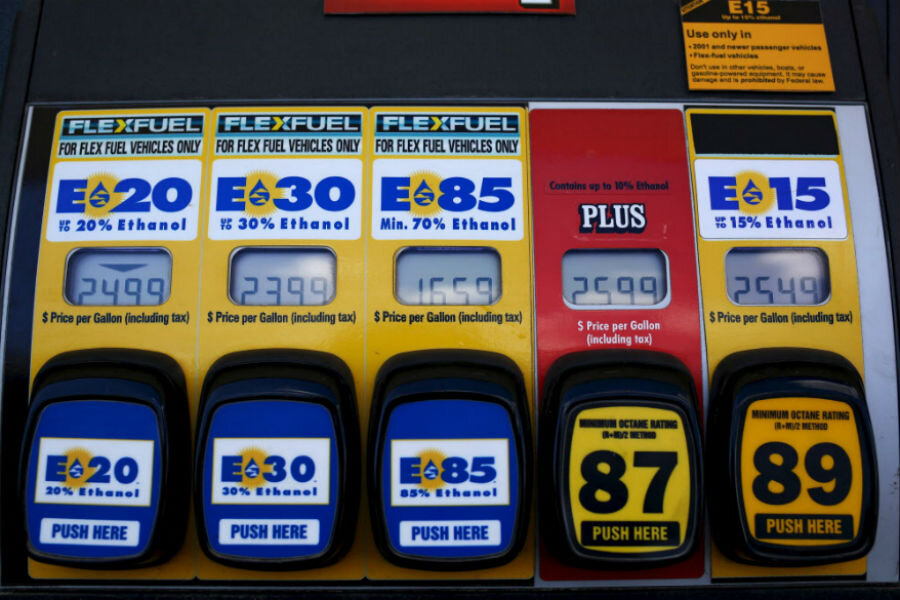Could ethanol be a cheaper alternative to hydrogen fuel cells? Nissan thinks so.
Loading...
When the world at large thinks of fuel-cell vehicles—to the extent it does, at least today—they are associated with hydrogen as the fuel to power them.
But a fuel cell, more broadly speaking, is any device that produces electricity from a variety of input fuels or energy carriers.
Tuesday, at a briefing in Japan, Nissan said it planned to develop vehicles using fuel cells powered by ethanol rather than hydrogen.
And, Nissan said, it will commercialize its technology by 2020, which is when the first vehicles to use the system will arrive.
It said that using liquid ethanol fuel as a source to generate hydrogen within the vehicle itself would be cheaper and easier than setting up a fueling infrastructure to deliver hydrogen at high pressures to vehicles around the world.
That's the approach taken by the three Asian makers whose fuel-cell vehicles will be on the market before the end of this year.
The Hyundai Tucson Fuel Cell, Toyota Mirai, and Honda Clarity Fuel Cell all store hydrogen at 10,000 psi in heavily reinforced tanks in the floor and cargo areas of the vehicle.
They must be fueled at the latest generation of hydrogen stations, which are now opening in Japan, northern and southern California, and Germany, among other locations.
Those stations cost $1 million to $2 million apiece, and building them often requires additional permitting and approvals compared to conventional liquid-fuel stations.
The technology Nissan plans to use in its future fuel-cell vehicles uses heat to reform ethanol into hydrogen to feed what is known as a solid oxide fuel cell, or SOFC.
In it, oxygen ions rather than protons move through the electrolyte to produce water and electricity.
The vehicle would include a tank for a blend of water and ethanol, which is fed into an onboard reformer that splits it into pure hydrogen and carbon dioxide.
The liquid fuel could be an ethanol-water blend at a 55:45 ratio, Nissan suggested.
The hydrogen produced in the reformer is fed into the solid-oxide fuel cell, which generates electricity at a relatively steady rate to supply power to the electric motor driving the wheels, through a battery that handles peak power demands and stores regenerated energy.
Heat from the fuel cell is used in the reformer, Nissan said, creating a highly efficient system.
Compared to vehicles that require hydrogen as fuel, the so-called "e-Bio SOFC" system can approach carbon neutrality, Nissan said.
That's because the carbon dioxide emitted during the process of reforming the ethanol into hydrogen has previously been removed from the air by the plants used to produce ethanol—whether corn, sugar cane, or other feedstocks.
Vehicles and refiners can adapt existing fuel-delivery infrastructure to provide ethanol, Nissan notes, rather than creating a high-pressure hydrogen delivery infrastructure from scratch and supplying it with hydrogen to be pumped into vehicles.
"The cost and energy required to produce hydrogen can be very high," said Nissan executive vice president Hideyuki Sakamoto at a media briefing, "and it also requires significant investment in (fueling and storing) infrastructure."
In addition, filling a tank with ethanol takes no longer than a gasoline fill-up. Nissan said its system would provide a range of up to 800 km (500 miles).
That's about one-third higher than that of the average gasoline vehicle.
The greater range comes from the more efficient process of reforming ethanol into hydrogen and using that in a fuel cell to produce electricity, which generates more energy to turn the wheels than burning gasoline at 25 to-30 percent average efficiency.
Nissan said it expected the cost of the ethanol-water blend used as fuel to be no higher than that of gasoline—and that the per-mile running cost could one day fall as low as that of plug-in electric cars.
The final cost to the consumer of hydrogen fuel delivered for a profit by private entities remains highly uncertain today, with some analysts suggesting it will always cost as much or more per mile than gasoline.
Nissan didn't indicate what kinds of vehicles it planned to launch with such a system.
One slide in its presentation, however, noted that battery-electric technology could be suited to smaller passenger vehicles while larger SUVs might use such a system to deliver zero-emission transportation at an affordable price.
This article first appeared at GreenCarReports.





